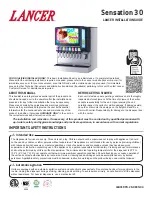
That portion of a tire that comes into contact with the road.
Tread rib
A tread section running circumferentially around a tire.
Tread separation
Pulling away of the tread from the tire carcass.
Treadwear indicators (TWI)
The projections within the principal grooves designed to give a visual indication of the degrees of wear of the
tread.
Vehicle capacity weight
The rated cargo a
nd luggage load plus 68 kilograms (150 lbs.) times the vehicle’s designated seating capacity.
Vehicle maximum load on the tire
The load on an individual tire that is determined by distributing to each axle its share of the maximum loaded
vehicle weight and dividing by two.
Vehicle normal load on the tire
The load on an individual tire that is determined by distributing to each axle its share of the curb weight,
accessory weight, and normal occupant weight (distributed in accordance with Table I of CRF 49 571.110) and
dividing by 2.
Weather side
The surface area of the rim not covered by the inflated tire.
Wheel center member
In the case of a non-pneumatic tire assembly incorporating a wheel, a mechanical device which attaches,
either integrally or separably, to the non-pneumatic rim and provides the connection between the non-
pneumatic rim and the vehicle; or, in the case of a non-pneumatic tire assembly not incorporating a wheel, a
mechanical device which attaches, either integrally or separably, to the non-pneumatic tire and provides the
connection between tire and the vehicle.
Wheel-holding fixture
The fixture used to hold the wheel and tire assembly securely during testing.
1.4. T
IRE
S
AFETY
-
E
VERYTHING
R
IDES
O
N
I
T
The National Traffic Safety Administration (NHTSA) has published a brochure (DOT HS 809 361) that
discusses all aspects of Tire Safety, as required by CFR 575.6. This brochure is reproduced in part below. It
can be obtained and downloaded from NHTSA, free of charge, from the following web site:
http://www.nhtsa.dot.gov/cars/rules/TireSafety/ridesonit/tires_index.html
Studies of tire safety show that maintaining proper tire pressure, observing tire and vehicle load limits (not
carrying more weight in your vehicle than your tires or vehicle can safely handle), avoiding road hazards, and
inspecting tires for cuts, slashes, and other irregularities are the most important things you can do to avoid tire
failure, such as tread separation or blowout and flat tires. These actions, along with other care and
maintenance activities, can also:
Improve vehicle handling
Help protect you and others from avoidable breakdowns and accidents
Improve fuel economy
Increase the life of your tires.
This booklet presents a comprehensive overview of tire safety, including information on the following topics:
Basic tire maintenance
Uniform Tire Quality Grading System
Fundamental characteristics of tires
49
Summary of Contents for 5600
Page 2: ......
Page 13: ......
Page 16: ...15 PARTS DIAGRAM ...
Page 18: ...17 ...
Page 19: ...18 ...
Page 23: ...22 OPTIONAL ACCESSORIES ...
Page 44: ...43 ...








































